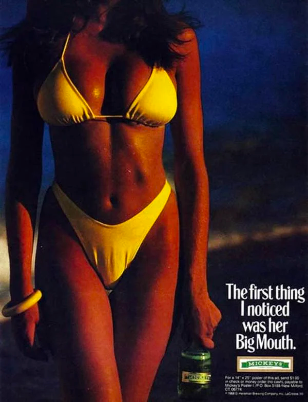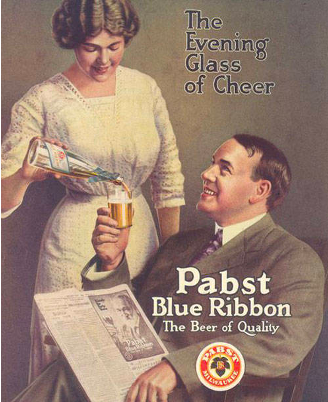Implications for brands when speaking to women
When we think about alcohol, we most likely think of good times and celebrations. While this still does, and probably always will ring true for most people, relationships with alcohol are changing. 2023 is a year of increased attention to inclusivity and diversity, and we’re seeing this come through strongly within the alcohol market especially when it comes to representing gender equality.
Before we get into some bold and best-in-class examples, let’s begin with a note on how far we’ve come. Remember the ‘Old Fashioned’ depictions of women in beer ads?
The Old Fashioned:
These ads were unfortunately rife with sexism, misogyny, and exclusion. Ultimately, if a woman was featured in early alcohol ads, it was typically shown serving a pint to their tired, hard working husband or used as an object for the male gaze.
But don’t just take our word for it!
"Ads with alcohol in brazil are always of hot girls with little clothing, killer bodies, shaking their butts, so they’re designed for men. It’s really weird because it's always a man, alone, drinking and looking at a hot woman, but in reality I do like to sit and have a drink by myself - although many would consider it weird because of the sexist society we live in."
- Fernanda, Rio de Janeiro, Brazil
Many of us are used to the gendered advertising in the industry, and likely grew up drinking against this backdrop.
“When I think of drinking advertisements, I think of provocative women, beaches. I just expect it - men and women both drink beer, but beer ads are often geared more towards men.” - Amanda, Arizona, USA
It’s true that some old drinking traditions were thrown out the window with COVID, bringing new trends like the rise of low/no alcohol). But cultures around alcohol and bars still hold concern for many people. Sexism and exclusion, but also danger and discomfort are real concerns, especially for female, non-binary, and POC drinkers, and are part of the reason Gen Z are more likely to abstain from it in general. At the same time, it can enable positive experiences, sensations, and emotions that many don’t want to miss out on.
Serving it to you neat:
Our research over the past year has shown many shifts in how people are looking to experience alcohol and how they want it to make them feel. Across genders, and especially for women, there’s an increased conscientiousness and interest in feeling more welcomed, and brands have a role to play here if they want it.
Four key themes stand out that define what women are looking to feel and experience through alcohol today. These are emerging opportunities for brands to tap into more inclusivity in their product marketing and comms.
CONNECTION | COMFORT | CONSCIOUS | (Less) CHAUVINISTIC |
|---|---|---|---|
To those close to you (family, friends, community) through traditions and rituals with alcohol To their own culture through drinking and celebrations To new people in social settings | Enough to choose, experiences with alcohol that are unique and personal Enough to express themselves through the drinks and brands they like Enough to break through post-pandemic social anxiety | Of the negative health implications (e.g. weight, addiction) Of the effects on mental health Of the financial cost of drinking, shifting in priorities … and are more likely to turn to low/no options | Rejecting more traditionally masculine, intimidating and boisterous behavior For women: more comfortable drinking different kinds of alcohol in certain environments, and drinking alone Men and women normalizing drinking what they want, whether it’s traditionally “girly” or “masculine” drinks |
Brands that recognize these shifted priorities can work towards connecting in more positive and meaningful ways, especially with a female audience. Many are doing so already, and innovating towards real change through representation and action.
How brands are ‘shaking it up’:
There is a huge opportunity for brands to connect positively with female drinkers, which in turn helps create a more equitable shift in drinking culture.
Here are some other innovative ways that businesses and big brands are addressing the issue in their organizations in in their products.

Molson Coors launched the hilarious “Bad $#!T to Good $#!T” campaign featuring comedian Ilana Glazer, showing their own sexist beer ads being turned into fertilizer. Acknowledging their part in the “dirty” past is one way for the brand to recognise its role in the issues, while forging a positive path forward.
Some brands are actually leaning into gendered differences by making specifically female-targeted drinks that stay away from the stereotypical marketing of ‘skinny’ drinks to women. Gallo Wines recently acquired the female founded canned wine and spritz brand, Bev., in a mission to “adapt and evolve to remain relevant to the next generation of alcohol beverage consumers” and as a means towards making social drinking more welcoming towards women. Time will tell if this is how younger generations want to be marketed to, or whether the more gender neutral branding success of white claw feels more relevant.
Sports is another huge growth opportunity in helping women to feel more welcome in social drinking occasions.
SportsBra is a queer-friendly bar in Portland, Oregon, which, in addition to being a fun and safe place for women and the LGBTQ+ community, is devoted to streaming women’s sports - something you’ll rarely find on the big screen at your local sports bar. They not only support and empower women’s sports, but also women-owned businesses in the local area, featuring food and beverages from local women-owned and women-made organizations.

Michelob Ultra was announced as the first alcohol sponsor of the Women’s Sports Network TV Channel, a huge and growing opportunity to amplify women’s voices and talent, and in an industry that alcohol brands are more than comfortable with.
From marketing campaigns to corporate restructuring, focusing efforts on gender equality definitely isn’t going anywhere.
Constellation Brands, the corporation behind Corona, Robert Mondavi wines, and SVEDKA, has committed $100 million to invest into female-led and founded companies over the next 10 years in their “Focus on Female Founders” initiative. They’ve already invested in Austin Cocktails and Vivify Beverages.
It’s encouraging to see companies not only say they want to uplift women and women’s voices, but concretely dedicate time, energy, and money to the cause.
Takeaways: how to ensure top shelf comms and strategic initiatives
All the aforementioned examples from big brands are evidence of the importance of balancing a need for representation and inclusion, while retaining elements of tradition that still connect strongly with this industry and women audiences.
When thinking of your brand, keep in mind the need for these two values when approaching the issue of gender and inclusivity:

Benevolence (via representation) is a basic necessity

Women are ready to see experiences and behaviors that are more equitable, empathetic, and culturally progressive from brands. They want to hear and see female voices in this space.
As Mallory O’Meara points out in her book, Girly Drinks: A World History of Women and Alcohol, women want to hear about the Bessie Williamsons (Laphroaig) and Barbe-Nicole Ponsardins (Veuve Clicquot) of the world. Brands can encourage more representation and benevolence in this space, in turn making a strong impact on culture as it intersects with drinking.

Security is essential in making everyone feel safe and welcome

Women have been involved in the creation, consumption, and enjoyment of drinking for centuries, whether it’s at a sports game or for a baby shower. They don’t need to be brought into the world of drinking, but they do need to feel safe and welcome.
Ensuring drinking spaces and the industry as a whole feels comfortable and secure is important in allowing women to thrive whether in the corporate world or at a bar with friends. Brands can do this through comms messaging, all the way to events and activations.
So, where to begin? Here are some thought starters for any brand in this space:
How can we authentically contribute to more benevolent and secure narratives that include and honor women?
What are my preconceptions and potential biases that I bring into this space?
Of the 4 C’s of modern drinking, is there a space or spaces that are more relevant to our brand/product?
What does “shaking it up” look like for us? What are the guardrails there?
Which of the good examples speaks to us, and why?











Comments